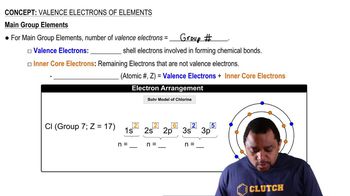Here are the essential concepts you must grasp in order to answer the question correctly.
Valence Electrons
Valence electrons are the outermost electrons of an atom and are crucial for chemical bonding and reactivity. They are found in the highest energy level (or shell) of an atom and determine how an element interacts with others. In transition metals like titanium (Ti) and hafnium (Hf), the d and s orbitals can contribute to the valence shell, influencing their chemical behavior.
Recommended video:
Transition Metals Valence Electrons
Electron Configuration
Electron configuration describes the distribution of electrons in an atom's orbitals. It is represented using a notation that indicates the energy levels and types of orbitals occupied by electrons. For Hf, the electron configuration is [Xe] 4f14 5d2 6s2, where the 5d and 6s orbitals are considered valence orbitals, while the 4f orbitals are core orbitals.
Recommended video:
Electron Configuration Example
Core vs. Valence Orbitals
Core orbitals are the inner electrons that are not involved in bonding and are typically closer to the nucleus, while valence orbitals are the outermost orbitals that participate in chemical reactions. In Hf, the 4f orbitals are core orbitals, and the 5d and 6s orbitals are valence orbitals, which play a significant role in its chemical properties and similarities to Ti.
Recommended video:
Main Group Elements Valence Electrons
 Verified step by step guidance
Verified step by step guidance


